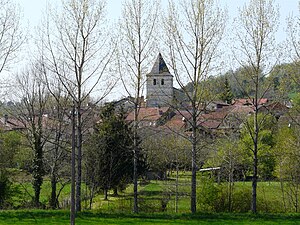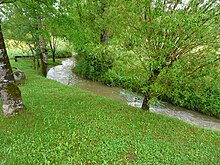Villars (Dordogne)
|
Villars Vilars |
||
|---|---|---|
|
|
||
| region | Nouvelle-Aquitaine | |
| Department | Dordogne | |
| Arrondissement | Nontron | |
| Canton | Brantôme | |
| Community association | Dronne et Belle | |
| Coordinates | 45 ° 25 ′ N , 0 ° 45 ′ E | |
| height | 125-240 m | |
| surface | 27.67 km 2 | |
| Residents | 463 (January 1, 2017) | |
| Population density | 17 inhabitants / km 2 | |
| Post Code | 24530 | |
| INSEE code | 24582 | |
 Villars town center |
||
Villars ( Occitan Vilars ) is a French commune with 463 inhabitants (as of January 1, 2017) in the northeast of the Dordogne department , Aquitaine region . It is on the border of the Périgord-Limousin Regional Nature Park .
geography
Villars is 10 kilometers northeast of Brantôme and 13 kilometers west of Thiviers (as the crow flies). The municipality is surrounded by the following neighboring municipalities:
- Milhac-de-Nontron in the north
- Saint-Martin-de-Fressengeas in the northeast
- Saint-Jean-de-Côle to the east
- Saint-Pierre-de-Côle in the southeast
- La Chapelle-Faucher in the south
- Champagnac-de-Belair in the southwest
- Quinsac to the west
- Saint-Front-la-Rivière in the north-west
In addition to the town center, the community consists of the following hamlets, farmsteads, a (now dilapidated) abbey and a castle:
Bionac , Bironnaud , Boschaud , Chabaneau , Château de Puyguilhem , Cirier-Bossu , Gaillarde , La Barbinie , La Barde , La Chaboussie , La Croix des Jarthes , La Gerbonnie , La Gorce , La Gourelle , La Peyzie , La Privadie , La Puychardie , Lafarge , Laschenaud , Lasmanas , Lavergne , Le Brandeau , Le Chatenet , Le Cheyroux , Le Cluzeau , Le Lumeyrac , Le Petit Chatenet , Le Pré du Pontau , Les Boussarias , Les Peycharias , Les Rebières , Les Sablières , Les Thomas , Les Vergnes , Maison Grande , Maison Neuve , Murat , Piche-Sèvre , Pressillac , Puy Chaud , Puyfavard , Puyjaloux , Puyruffet , Sefon and Tranchillon .
The municipality of Villars is drained roughly in the middle of the Trincou in a south-south-west direction. Shortly before the town center, the Trincou takes up the Etang Rompu stream coming from the northeast as a left branch . A dry valley running to the west- south- west forms the southern border of the municipality with La Chapelle-Faucher, this then flows into the Trincou on the left (already in the municipality of Champagnac-de-Belair). In the town center, the Trincou also takes on a small, right-hand side stream coming from the northwest, which flows past Puyguilhem Castle .
The topographically lowest point in the municipality with 125 meters is located in the southwest near La Gorce ; here the Trincou leaves the municipality in a south-westerly direction. The highest point at 240 meters is at Piche-Sèvre on the eastern border.
geology
The municipality of Villars is completely underlain by flat sedimentary rocks of the northeast Aquitaine basin . The oldest layer sequences come from the Dogger , more precisely from the Upper Bajocium . Oolite limestone was deposited , to be seen at Le Cluzeau and at the Villars cave . This is followed by cryptocrystalline limestone , bioclastic limestone and partly lignite- bearing claystones of the Lower Bathonian (occurrence near Maison Neuve ); its limestone can also be recrystallized in places . The Dogger ends with cryptocrystalline limestone of partly chalky character and coarse detritic limestone of the upper bath (near Les Thomas ). The Cenomanium then transgressed over the Dogger . The cenoman consists of green, oyster- bearing marls , fine sands and sandy alveoline limestone . It lies beneath the town center and lines the left side of the Trincou valley and the left side of the Étang Rompu above the town. The Cenomanium is concordantly followed by the Turonium with the chalk limestone of the Ligérien ( Villars Formation ) and the rudist limestone of the Angoumien . The uppermost layer consists of hard, crystalline limestone of the Coniacium , to be seen in the south at La Gorce .
The Jurassic-Cretaceous layer sequence is at altitudes mostly of tertiary obscured Hüllsedimenten starting with probably from the Eozän derived Colluvium (rearranged during the Pleistocene ), which for its part of altpleistozänem alluvium (river gravel, tongues at La Peyzie , Puy Chaud , Puyfavard and Tranchillon superimposed) becomes. To the south of the town center there is a Wurmzeit gravel terrace on the Trincou . Debris layers along the Trincou and the Étang-Rompu also go back to the last Ice Age .
Several smaller disturbances cross the shift structure. The center is, for example, by means of NO and O-trending disorders horst-like raised and also the southwest at Pressillac and Cirier-Bossu is a structural high, which is delimited by two SO-sweeping dislocations.
history
The presence of humans can be traced back to the Lower Magdalenian using animal representations in the Villars Cave (approx. 17,000–15,000 years BP ). The Romanesque church of Saint-Martial was built in the 12th century . In 1154 founded the Cistercian the Abbey Boschaud , but which in the course of the 16th century during the French religious wars in the 17th century during the Fronde was destroyed again. Puyguilhem Castle was built in the 16th century.
Population development
| Population development in Villars | ||||
|---|---|---|---|---|
| year | Residents |

|
||
| 1962 | 802 | |||
| 1968 | 735 | |||
| 1975 | 647 | |||
| 1982 | 586 | |||
| 1990 | 568 | |||
| 1999 | 526 | |||
| 2008 | 479 | |||
| 2016 | 467 | |||
Source: INSEE
The population in Villars has been steadily declining since 1962, but the decline has slowed somewhat since 1982.
Attractions
- Romanesque fortified church of Saint-Martial
- Boschaud Cistercian Abbey
- Puyguilhem Castle , protected as a monument historique since 1992
- Villars cave
Transport links
The town center is reached by the D 82 coming from the northeast, which connects to the D 707 from Saint-Pardoux-la-Rivière to Thiviers . The D 82 E leads through the Trincoutal from Milhac-de-Nontron to Villars. The D 3 from Nontron and the D 68 from Saint-Pierre-de-Côle also arrive in the center . The D 3 then continues through the southern Trincoutal towards La Chapelle-Faucher. In the eastern part of the municipality, the D 98 branches off in an easterly direction from the D 86 to Saint-Jean-de-Côle. The same D 98 leaves the D 3 behind the Puyguilhem Castle to the west and turns towards Quinsac.
Long-distance hiking trail
The long-distance hiking trail GR 436 , coming from Saint-Jean-de-Côle, crosses the municipality from east to west and continues towards Champagnac-de-Belair and Brantôme.¨
Individual evidence
literature
- P.-L. Guillot et al .: Feuille Thiviers . In: Carte géologique de la France à 1/50000 . BRGM.
- Dominique Richard (Ed.): Le Guide Dordogne-Périgord. Fanlac, Périgueux 1993, ISBN 2-86577-162-8 .


